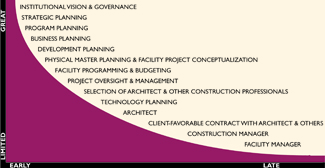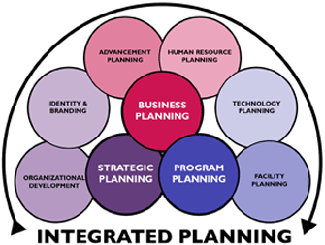Before You Hire an Architect
—and When You Do, How to Hire Wisely
Facilities are an extraordinarily expensive solution to any need. If you need to build—or think you might—there are ways to reduce your costs, your risks and your stress, and increase the benefits you will derive from your new or renovated facility. Many of these actions are not things that you’d know to consider if you don’t build regularly; some will likely be overlooked even if you have a full-time facilities department.
The Order of Things
For many institutions, the first reaction to any perceived need in facilities is the instinct to hire an architect (or even a design-build contractor). Unfortunately, the design skills that an architect can offer are only one factor in a wise, cost-effective, and long-term solution to facilities issues. And they are far from the first step.

Degree of control over budget at various points
Design and construction are expensive acts of execution; major expenses (and major mistakes) can be avoided by starting with the most fundamental steps of institutional planning and following them in sequence, to make certain that all of the right questions are being asked. The needs and answers that initially seem obvious often miss the real opportunities.
The first step should be some combination of strategic, program, and business planning (see CI #1: Why Plan?, CI #5: The Structure of Planning, CI #12: Business Planning, and CI #11: Integrated Planning. Only with a fully current consensus on vision and strategy, reinforced by a clear evaluation of program needs and a tough and thorough business plan, can an institution hope to conceive, design and build the right facilities—if, indeed, facilities are the right solution at all.

After the strategic, program and business questions have been clarified, a physical master plan can be developed not just to frame a course of action for the present, but to avoid foreclosing options to meet future needs. A physical master plan should be thought of not as a long-term recipe, but as an evolving projection to be reassessed after any significant change in strategic and program planning.
Once you have brought all of your planning up to date, you will be in a position to evaluate the need for a new facility.
When thinking about any new construction project, the first question to ask is whether there is any way to avoid building a new building. Are there non-facility solutions that might address the problem without incurring the extraordinary expense of construction? Can functions be shuffled to re-balance under-used areas with over-used ones? Can an existing building be transformed more cheaply than a new one can be built? Or vice versa?
Define the Project
If construction is unavoidable, what is needed to define the project?
Nonprofit clients often know far too little about their specific needs and objectives before moving into the design of physical facilities. Often they identify some very general issues and expect an architect to figure out the details. Left to their own devices, architects will necessarily invent forms and functions that represent only a limited insight into the needs and wisdom of their client. If, on the other hand, architects are given clear and precisely articulated goals, they may be able to reflect the aspirations of their clients in striking ways. And not necessarily at any greater cost.
An institution is best served when it prepares an architectural program and a project budget before selecting an architect. A well-developed program document will help you first to budget the project, then to select and guide an architect well-matched to your intentions, and then to measure the design work against your goals. The traditional quantitative program lists all of the spaces required—down to utility rooms and closets—with their purposes, detailed characteristics, areas in square feet, all of the equipment needed, and important adjacencies (spaces that should be next to each other for proper functioning).
Beyond these quantitative parameters, it can be especially effective to develop a qualitative program, as well. This qualitative program can consist of the character of spaces, values of the organization, and messages about the organization to be communicated to the public. By articulating carefully issues of function, expression and meaning, the qualitative program can mold the facilities of an institution to support most effectively its mission, identity, and marketing objectives.
On the basis of a detailed architectural program, an accurate project budget can be developed. This budget will enable you to:
- assess financial and fundraising capacity
- approve the project with confidence
- instruct the architect clearly and hold him/her accountable for designing to budget
- put any later temptation to expand the project into context, and require an explicit, intentional decision for any resulting budget increase
As with all subsequent budgeting, this should be a comprehensive project budget, not just a construction budget. It should include construction costs, soft costs (all fees, furniture, and equipment), an allowance for contingencies (a figure that is gradually consumed or reduced during design and construction) and, ideally, a building operation and maintenance endowment. Such an all-inclusive project budget is the only way to avoid misunderstandings and surprises.
Assess Capacity
Once you have defined the project, you can assess whether you have the resources to support it or a modified version of it. Most obviously there is the question of financial capacity. You will likely want to conduct a fundraising feasibility assessment to ascertain an achievable goal for a capital campaign. You may be willing and able to borrow a portion of the funds needed for the project. If so, there may be a variety of possibilities available to you, from bank lines of credit to state-sponsored revenue bonds. Under certain circumstances, you may wish to consider a loan from your own endowment.
Borrowing may seem a much more palatable option if the project offers significant revenue-generating potential (e.g. dormitories or facilities for social enterprise initiatives), so you may well want to analyze this possibility. A real-time, interactive financial model (CI #6) can be extraordinarily useful at this stage, allowing management and board to test and visualize consequences for a variety of scenarios.
In addition to financial capacity, you will also have to ascertain whether you have the available real estate. If you have an existing master plan, this may be a simple question that has already been examined. If you do not have a master plan, you should consider whether you can afford to work without one.
Finally, there is administrative capacity. A large institution will likely have a facilities department with full-time project managers, bookkeepers, and other personnel, as well as procedures for handling design and construction. A small institution may have little idea of the complexities involved in such projects. By the time it finds out, it may have incurred significant unnecessary expenses. A project needs to be planned administratively as well as physically.
Who Will Be Involved in the Project?
Trustees and administrators who have not been involved in an institutional design and construction project often have no idea of the complex nature of the work required.
The first question is whether the organization has the in-house staff necessary to oversee a project of the size envisioned. Unless you are a large enough an institution to have an established facilities department staffed with project managers and support staff, additions to staff are likely for anything but the smallest of projects. (Costs associated with these new positions should be considered among the “soft costs” of a project.)
The primary need will be for a project manager with the experience and authority to manage the process, facilitate communication among all parties, make most of the operational decisions, and channel the decisions that require executive or board approval expeditiously and with clear analysis of options and repercussions. Some of these tasks are beyond the skill set of a typical facility project manager; it generally helps to have a senior staff member act as project director to make or facilitate major decisions. Depending on the size of the project, you will probably need part or full-time bookkeeping and accounting help, and staff support for the project manager. Depending on the skills and experience of the project manager, an out-sourced “owner’s representative” may also be needed. (It is also possible to hire outside professionals for the entire project management function, but that can be more expensive and requires an unusual degree of comfort and confidence in the outsider.)
Beyond the direct project staff issues, a major project also will affect the overall rhythms of management and governance in institutions not accustomed to building. It will be important to define clearly a hierarchy of levels for engaging executives and board committees in design decisions and tradeoffs, and especially in financial decisions. Once design and construction begin, delays in decision-making and changes of direction can be very costly. The more clear and streamlined the process the more likely you will stay on budget, on time, and happy with the results.
Project Delivery Decisions
In addition to deciding whether to do a project, and how to oversee it properly, delivery methods you may wish to consider, based on the nature and complexity of the project, and the pool of expertise available.
For very simple and small projects you might want to use a design/build approach, which can simplify the logistics and lower costs. For anything more complex, however, you will give up too much—in terms of cost or quality of results or both—if you don’t separate design and construction.
Generally you will use an architect, with a battery of appropriate engineering and technical consultants, for design. For construction, you will have to choose between using a general contractor and a construction manager. In simplest terms a general contractor bids competitively a fixed amount for your project and then works with subcontractors as he or she chooses. A construction manager works with you on a fee basis to get the best prices from subcontractors. If the project or parts of it comes in below budget, the construction manager may get part of the savings as an incentive. Many variables go into the decision of which approach to use, and in either case, careful crafting of a client-centered contract can have major cost and risk advantages over using the stock contracts offered by building industry professional associations.
Selecting Architects and Contractors
Once you have fully prepared yourself internally to pursue a project, the next challenge is to select an architect who will be able to work with you to realize your objectives. There are easy ways to find an architect, and there are effective ones. The effective ones require knowledge, research, discussion, and time. (See Selecting an Architect & CI #10: Mind Your RFPs & Qs)
Controlling Time, Money, and Quality
Whatever internal or external systems you use for project management, and whatever project tracking and reporting methods you select, be aware that all levels of an institution have an oversight role to play in a building project. Architects and contractors have their own priorities and value systems; it is inevitable that substantial budget and quality issues will arise that are beyond the mandate of the project manager to settle. It is essential to have an oversight committee that keeps close enough watch to address potential problems before they get more costly than necessary to correct.
With so much at stake, you should keep in mind the interrelationships among time, money, and quality in any project: trying to get a project done faster than it might normally take will drive up costs and drive down quality. In making any decisions also remember the expertise and tough management required to maintain the balance you select.
Want to know more about all of this?
Contact Sam Frank at 617 969 1881 or [email protected].